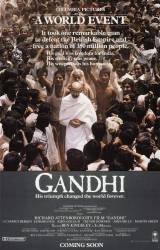Corrected entry: At approximately one hour into the film, Gandhi is shown wearing wire rimmed glasses with round lenses. At approximately the two hour point, the lenses now have a bi-focal segment that is a half circle in the lower section of the round lens. The addition of bi-focal lenses is consistent with the aging process, since the eyes can no longer focus on nearby objects. With bi-focal lenses, the lower portion of the lens is used for reading and the upper portion of the lens is used for distance. However, in subsequent scenes, Gandhi's glasses sometimes have the bi-focal lenses and sometimes they do not. His glasses alternate between bi-focal and regular lenses approximately seven times throughout the rest of the film. At the end, he is wearing black rimmed glasses without bi-focal lenses.
Corrected entry: When one of the old British people is drinking coffee, what's in the cup isn't liquid, it doesn't move or splash around, it appears to be some kind of solid brown formation.
Correction: If it's John Gielgud, then I think the confusion arises because the inside-bottom of the cup is painted dark blue.
Corrected entry: The film shows Ghandi being beaten in South Africa for burning identity passes. While the protest did happen, Ghandi himself was not beaten.
Correction: History may tell us differently, but this film is not intended to be a historical documentary. Although the film is based on Gandhi's biography, it is a standard accepted movie convention for filmmakers to employ artistic license and to deliberately alter, add or disregard historical facts for dramatic purposes.
Corrected entry: British actor Ben Kingsley who played Mahatma Gandhi is of Indian and English descent.
Correction: This is trivia about Ben Kingsley, not about the film Gandhi.






Correction: My mother has two pairs of glasses - one bifocal, one regular. It is possible to have two sets and use them for different times.
LorgSkyegon